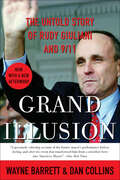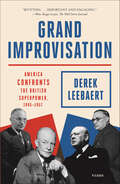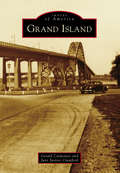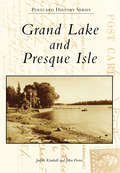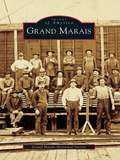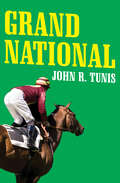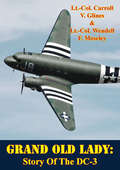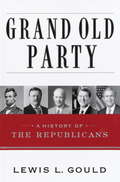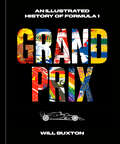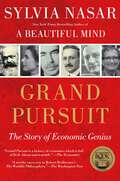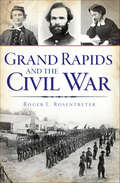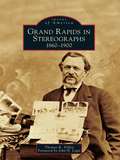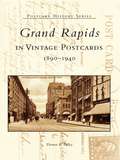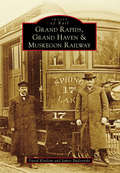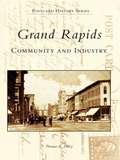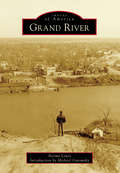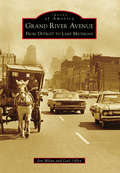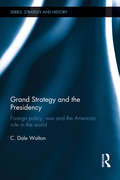- Table View
- List View
Grand Illusion: The Untold Story of Rudy Giuliani and 9/11
by Dan Collins Wayne BarrettRudy Giuliani emerged from the smoke of 9/11 as the unquestioned hero of the day: America's Mayor, the father figure we could all rely on to be tough, to be wise, to do the right thing. In that uncertain time, it was a comfort to know that he was on the scene and in control, making the best of a dire situation.But was he really?Grand Illusion is the definitive report on Rudy Giuliani's role in 9/11—the true story of what happened that day and the first clear-eyed evaluation of Giuliani's role before, during, and after the disaster.While the pictures of a soot-covered Giuliani making his way through the streets became very much a part of his personal mythology, they were also a symbol of one of his greatest failures. The mayor's performance, though marked by personal courage and grace under fire, followed two terms in office pursuing an utterly wrongheaded approach to the city's security against terrorism. Turning the mythology on its head, Grand Illusion reveals how Giuliani has revised his own history, casting himself as prescient terror hawk when in fact he ran his administration as if terrorist threats simply did not exist, too distracted by pet projects and turf wars to attend to vital precautions.Authors Wayne Barrett and Dan Collins also provide the first authoritative view of the aftermath of the 9/11 attacks, recounting the triumphs and missteps of the city's efforts to heal itself. With surprising new reporting about the victims, the villains, and the heroes, this is an eye-opening reassessment of one of the pivotal events—and politicians—of our time.
Grand Improvisation: America Confronts the British Superpower, 1945–1957
by Derek LeebaertA new understanding of the post World War II era, showing what occurred when the British Empire wouldn’t step aside for the rising American superpower—with global insights for today.An enduring myth of the twentieth century is that the United States rapidly became a superpower in the years after World War II, when the British Empire—the greatest in history—was too wounded to maintain a global presence. In fact, Derek Leebaert argues in Grand Improvisation, the idea that a traditionally insular United States suddenly transformed itself into the leader of the free world is illusory, as is the notion that the British colossus was compelled to retreat. The United States and the U.K. had a dozen abrasive years until Washington issued a “declaration of independence” from British influence. Only then did America explicitly assume leadership of the world order just taking shape. Leebaert’s character-driven narrative shows such figures as Churchill, Truman, Eisenhower, and Kennan in an entirely new light, while unveiling players of at least equal weight on pivotal events. Little unfolded as historians believe: the Truman Doctrine and the Marshall Plan; the Korean War; America’s descent into Vietnam. Instead, we see nonstop U.S. improvisation until America finally lost all caution and embraced obligations worldwide, a burden we bear today.Understanding all of this properly is vital to understanding the rise and fall of superpowers, why we’re now skeptical of commitments overseas, how the Middle East plunged into disorder, why Europe is fracturing, what China intends—and the ongoing perils to the U.S. world role.
Grand Inquests: The Historic Impeachments Of Justice Samuel Chase And President Andrew Johnson
by William H. RehnquistRecounts two precedent-setting impeachment cases that strengthened the concept of separation of powers and further defined the institutions of American government
Grand Island
by June Justice Crawford Gerald CarpenterWhen people think of Grand Island, they invariably picture the bridges connecting it with Buffalo to the south and Niagara Falls to the north. They might also think of it as a pleasant and conveniently located suburb or envision the island's natural beauty with the majestic Niagara River flowing serenely around it. But there were no bridges before 1935, and most people know little of the island's long, fascinating history up to that time. To the Iroquois, it was a valued hunting and fishing preserve; to British and French imperialists, a contested frontier asset. After American independence, it became whatever people could dream up--a tax-free utopian settlement, a refuge for Europe's persecuted Jews, a source of timber for Yankee clipper ships, a summer retreat for the wealthy, a playground for the masses, or a collection of small farm villages--all before it assumed its suburban form. Its colorful story, presented through this book's images, emerged from interactions between its unique geography and human imagination.
Grand Junction
by Alan KaniaThe Ute Indians were hardly out of western Colorado when their land was opened to Anglo settlers. It was on September 26, 1881, when George A. Crawford, William McGinley, R. D. Mobley, M. R. Warner, and others went to the junction of the Gunnison and Grand (later renamed the Colorado) Rivers to claim 640 acres. In the semiarid confluence of the two rivers, a city developed, fruit orchards were planted, and a college grew out of the seeds of a single-room school with a dirt floor. Several newspapers opened, providing news and information to a business community that included coal mining, railroads, dry goods, and even a toffee factory whose products have graced the tables of royalty. How Grand Junction was able to develop into a progressive community of entrepreneurs, educators, and community-minded citizens is a story best told in a small sampling of pictures. None of the founders are still here, but their legacy, stories, and pictures have survived to speak for them.
Grand Lake and Presque Isle (Postcard History Series)
by John Porter Judith KimballFor centuries, Presque Isle served as a way station for Native Americans and explorers. Lumbering and shipping led to the development of wooding stations along the Lake Huron shore, where settlements emerged. The roads created by loggers eventually led to the building of resorts and hotels for tourists. Postcard History Series: Grand Lake and Presque Isle explores Burnham's Landing, the abandoned community of Bell, Presque Isle's two renowned lighthouses, two youth camps, the new limestone mining industry at Rockport, and other important sites. Some 20th-century visitors bemoaned water that was too cold, fish that were not biting, journeys that were too long, or visits that were too short. The postcard messages indicate that they knew Grand Lake and Presque Isle would remain in their hearts and minds until they could return.
Grand Marais
by Grand Marais Historical SocietyThe village of Grand Marais, on the south shore of Lake Superior in Michigan's Upper Peninsula, is one of the oldest inhabited places on the Great Lakes. Native Americans camped along its beautiful natural harbor, naming it Kitchi-bitobig, or "Great Pond." The French voyageurs traded furs along these shores, and in the early 1860s, a trading post was established. The lumber boom soon followed, and by the mid-1890s, Grand Marais was a bustling town of 2,000 inhabitants. The good times did not last, and by 1911, the sawmills closed, the railroad pulled out, and almost overnight the population dwindled to a mere 200 or so. But Grand Marais refused to die, and those hardy individuals who stayed somehow found a way to make a living, many in the commercial and sport fishing industries. The opening of a state road into town brought vacationers to enjoy the many recreational delights of the area. Today Grand Marais is a popular tourist destination that still retains its small-town friendliness and historic atmosphere.
Grand National
by John R. TunisJack Cobb has lost everything—his wife, his son, his career—but a thoroughbred horse named Quicksilver may give him a new lease on life Recently widowed Baltimore stockbroker Jack Cobb is increasingly disheartened when his son, Stan, loses interest in pursuing his college degree in history. Stan prefers riding his thoroughbred horse, Quicksilver, and sees little point in academic work when he is about to be drafted into the army to fight in Vietnam. Barely a month into his first tour of duty, Stan is killed by a civilian in the street, and soon after that Jack&’s business begins to fail. Forced to sell the house, Jack stakes his last hope on Stan&’s beloved horse and enters Quicksilver into the prestigious Grand National in Aintree, England.
Grand Old Lady: Story Of The DC-3
by Lt.-Col. Wendell F. Moseley Lt.-Col. Carroll V. GlinesThis is a most excellent chronological history of the iconic DC-3 (Douglas Commercial aircraft, third model), also known as the C-47 (Cargo) in the US Army Air Forces and R4D in the US Navy, Good Old Gooney Bird, Dear old Dakota, and Grand Old Lady. She was noisy, drafty, easy to fly and utterly dependable. One thing Donald Douglas demanded was that she hold her altitude on one engine. She became the luxury airliner of the late 1930s and made air travel practicable. More than 11,000 DC-3s were built for the military during World War II, and several hundred are still flying. This book defines the versatility of this aircraft for delivering cargo of all kinds, dropping paratroopers, evacuating wounded, towing gliders (three at a time), and, with engines removed, being gliders, landing on studded snow tires, skis or pontoons as the mission required, then being reconverted to airline service after the war.--Print Ed.
Grand Old Party: A History of the Republicans
by Lewis L. GouldFrom Abraham Lincoln and the Civil War through the disputed election of George W. Bush and beyond, the Republican Party has been at the dramatic center of American politics for 150 years. In this exciting new book, the Þrst comprehensive history of the Republicans in 40 years, Lewis L. Gould traces the evolution of the Grand Old Party from its emergence as an antislavery coalition in the 1850s to its current role as the champion of political and social conservatism. Gould brings to life the major Þgures of Republican history--Lincoln, Theodore Roosevelt, Dwight D. Eisenhower, Richard Nixon, Ronald Rea-gan, and George W. Bush--and uncovers a wealth of fascinating anecdotes about Republicans, from "the Plumed Knight," James G. Blaine, in the 1880s, to Barry Goldwater in the 1960s, to Newt Gingrich in the 1990s. Gould also uncovers the historical forces and issues that have made the Republicans what they are: the crusade against slavery, the rise of big business, the Cold War, and opposition to the power of the federal government. Written with balance and keen insight,Grand Old Partyis required reading for anyone interested in American politics. Republicans, Democrats, and independents alike will Þnd their understanding of national politics deepened and enriched. Based on Gould's research in the papers of leading Republi-cans and his wide reading in the party's history, Grand Old Party is a book that will outlast the noisy tumult of today's partisan debates and endure as a deÞnitive treatment of how the Republicans have shaped the way Americans live together in a democracy. For the next presidential election and for other electoral contests to come, this book (a perfect companion toParty of the Peopleby Jules Witcover, a history of the Democratic Party published simultaneously by Random House) will be an invaluable guide to the unfolding saga of American politics. From the Hardcover edition.
Grand Opening
by Jon HasslerTwelve-year old Brendan tells the story, set in 1944-45, that begins with his parents' decision to buy a run-down grocery store in a tiny Minnesota town. What they discover about small town idealism, bigotry, and good old American values will change them and the town forever. "A writer good enough to restore your faith in fiction." THE NEW YORK TIMES BOOK REVIEW.
Grand Prix: An Illustrated History of Formula 1
by Will BuxtonNEW YORK TIMES BESTSELLER • A thrilling illustrated history of Formula 1 racing, from its fascinating origins and inner workings to the top drivers of the twentieth century and today, by a celebrated motorsports broadcaster and star of Formula 1: Drive to Survive&“A valuable and welcome addition to the library of any lifelong F1 fan, as well as for any curious individual new to the world of F1.&”—Mario Andretti Over its seventy-plus years of history, Formula 1 racing has grown from a niche motorsport with just a few events per season into a global phenomenon followed by more than a billion fans. With just twenty drivers competing at speeds of over 220 miles per hour on more than twenty of the world&’s most glamorous and challenging racetracks, Formula 1 is the ultimate test of machine and humankind. To become a champion means to be counted among the most elite athletes the world has ever known.As the lead commentator on Netflix&’s breakout series Formula 1: Drive to Survive, Will Buxton has emerged as the most prominent journalist covering the sport for the new generation of fans. Grand Prix chronicles the past, present, and future of F1 in an engaging and easily digestible format. You&’ll be introduced to historical heroes, such as Formula 1&’s very first world champion, Giuseppe Farina, through every decade and every champion of the sport, including the iconic Lewis Hamilton and reigning champion Max Verstappen. You&’ll meet the drivers these great champions did battle with and discover the teams they raced for and the tracks they mastered. Packed with incredible stories and epic races, this captivating collection also contains features on every aspect of the sport today, along with how modern teams operate from their factories to race weekend garage setups, car design, the development of the sport through the lens of automotive evolution and safety, the art of the pitstop, and the future of motor racing.Filled with immersive and engaging information with illustrations as dynamic and bold as the sport itself, Grand Prix is the definitive introduction to the world's fastest sport.
Grand Pursuit: The Story of Economic Genius
by Sylvia NasarIn a sweeping narrative, the author of the megabestseller A Beautiful Mind takes us on a journey through modern history with the men and women who changed the lives of every single person on the planet. It’s the epic story of the making of modern economics, and of how economics rescued mankind from squalor and deprivation by placing its material fate in its own hands rather than in Fate. Nasar’s account begins with Charles Dickens and Henry Mayhew observing and publishing the condition of the poor majority in mid-nineteenth-century London, the richest and most glittering place in the world. This was a new pursuit. She describes the often heroic efforts of Marx, Engels, Alfred Marshall, Beatrice and Sydney Webb, and the American Irving Fisher to put those insights into action—with revolutionary consequences for the world. From the great John Maynard Keynes to Schumpeter, Hayek, Keynes’s disciple Joan Robinson, the influential American economists Paul Samuelson and Milton Freedman, and India’s Nobel Prize winner Amartya Sen, she shows how the insights of these activist thinkers transformed the world—from one city, London, to the developed nations in Europe and America, and now to the entire planet. In Nasar’s dramatic narrative of these discoverers we witness men and women responding to personal crises, world wars, revolutions, economic upheavals, and each other’s ideas to turn back Malthus and transform the dismal science into a triumph over mankind’s hitherto age-old destiny of misery and early death. This idea, unimaginable less than 200 years ago, is a story of trial and error, but ultimately transcendent, as it is rendered here in a stunning and moving narrative.
Grand Rapids
by Alex Forist Tim GleisnerFor millennia, people have gathered at the rapids of the Grand River, the place where downtown Grand Rapids now stands. From its earliest recorded history in the 1820s as a tiny frontier trading post, through many booming decades as the "Furniture City," to its newest reinvention as a center of public art, Grand Rapids has a fascinating history. By 1850, when the city was incorporated, several early industries, including logging, milling, and brewing, were already established, and the groundwork for the incredibly lucrative furniture industry was in place. As more people came to Grand Rapids from all over the world, they developed institutions and settled the city's distinctive neighborhoods, each reflecting their nationalities, religions, and aspirations for the future. Throughout its history, from Campau to Calder, Grand Rapids has remained a place for pioneers.
Grand Rapids Food: A Culinary Revolution (American Palate)
by Lisa Rose StarnerGrand Rapids' food scene is bursting with local flavor. Farmers, teachers, chefs and activists are taking back their foodways and serving up the fresh, healthful fruits of their labor. Author Lisa Rose Starner captures the essence of the growing food movement in Grand Rapids and the rugged individuals who are tilling the soil, growing food and launching successful food businesses while powering community change--one garden, one backyard, one block, one store, one plate of food, cup of coffee and mug of beer at a time.
Grand Rapids and the Civil War (Civil War Series)
by Roger L. RosentreterGrand Rapids responded to President Abraham Lincoln's call for troops with passionate swiftness. Kent County men fought stubbornly on memorable battlefields like First Bull Run, Stones River and Gettysburg, as well as obscure places like Boonville, La Vergne and Mossy Creek. An affinity for cavalry earned Grand Rapids the moniker "Michigan's Horse Soldier City," while Valley City engineers designed and constructed spectacular railroad bridges throughout the South. Back home, the soldiers' mothers, wives and sisters faced the conflict's many challenges with patriotic doggedness. Dr. Roger L. Rosentreter chronicles how Grand Rapids citizens responded to wartime trials and tribulations while helping the North save the Union and end slavery.
Grand Rapids in Stereographs: 1860-1900 (Images of America)
by Thomas R. Dilley John H. LogieBeginning around 1865, as the fledgling art and science of photography began to appear in cities and towns across the United States, a small group of photographers, using new methods and equipment developed a few years before in Europe, began producing and offering for sale stereographic views of the people, places, and events that made up daily life in the then nearly 40-year-old city of Grand Rapids. These photographic views were unlike othersthat had preceded them and when viewed using a special device, they presented a detailed, three-dimensional portrait of the young city. Once introduced, stereographic views of the city, alongside those of more distant lands, became wildly popular and soon graced the homes of many in this city and elsewhere. The stereographic cards themselves today offer a rare and detailed glimpse ofthe city, its residents, and some of the special and unusual events that occurred nearly 150 years ago.
Grand Rapids in Vintage Postcards: 1890-1940 (Postcard History)
by Thomas R. DilleyGrand Rapids, Michigan, began to take shape when settlers found power, transportation, and abundant natural resources on the banks of the Grand River. A gateway to the settlement of western and northern Michigan in the mid- to late 19th century, Grand Rapids became home to a fledgling cottage industry in the manufacture of furniture. In the decades that followed, the furniture industry brought employment and prosperity to the city, and significantly influenced its physical landscape and character. The history of Grand Rapids during the late 19th and early 20th centuries has been documented in the postcards of the period. Hundreds of scenes of buildings and institutions, and the people who lived, worked, and played here were recorded on these cards.
Grand Rapids, Grand Haven, and Muskegon Railway (Images of Rail)
by David Kindem James BudzynskiThe Grand Rapids, Grand Haven & Muskegon (GRGH&M) Railway was part of a network of electric railroads that spread across southern Michigan in the early part of the 20th century. For nearly 30 years, the railway connected Grand Rapids with Muskegon and Grand Haven on the Lake Michigan shore. The fast and frequent service it offered transformed life in Coopersville, Nunica, Berlin (now Marne), Fruitport, and other smaller communities along the way. In addition, the railway and the boats of the Goodrich and Crosby steamship lines provided an overnight connection with Chicago and Milwaukee. Moving both people and freight, this interurban had an important impact on both local and regional economies. Images of Rail: The Grand Rapids, Grand Haven & Muskegon Railway traces the history of the electric interurban in West Michigan, telling the story of the growth, operation, and eventual demise of an important electric railway in the region.
Grand Rapids: Community and Industry (Postcard History)
by Thomas R. DilleyIn the years between 1890 and 1950, the city of Grand Rapids grew from a small Midwestern town of great potential into a large and important commercial and manufacturing center. With the growth of the city and its population came a large variety of activities, commercialand recreational, which were happily recorded in a huge array of postcards produced by both local and national printers. These cards and the moments they preserve provide a unique glimpse into the life and growth of Grand Rapids.
Grand River (Images of America)
by Norma Lewis Michael GutowskyAt 265 miles, the Grand River is Michigan's longest waterway, and it was once considered one of the Midwest's most important. The river starts as a trickle just south of Jackson and gains power as it surges toward Lake Michigan in Grand Haven. Trappers first used the river to trade with the Native American villages along its banks. Later, the lumber industry transported logs via the Grand. The river shaped the towns and cities that grew up along its banks, providing them with transportation and power for manufacturers, including the once-renowned Grand Rapids furniture industry. Fertile farmlands have always played an important role in the history of the Grand River Valley. Today, the river is used primarily for recreation, including boating, fishing, and, in Grand Ledge, rock climbing.
Grand River Avenue
by Jon Milan Gail OffenGrand River Avenue, or Michigan US-16 as it was ultimately designated, is one of Michigan's true "Blue Highways"--an original two-lane, blacktop road still serving as a direct path through roadside America. Originally a Native American trail, this ancient path has been a westbound route from the Straits of Detroit to the eastern shores of Lake Michigan for more than 1,000 years. Over time, it has served as a footpath, horse trail, wagon rut, stagecoach route, plank road, and ultimately a two-lane highway that gave some of America's earliest motorists their first taste of long-distance automobile travel.
Grand Strategy and Military Alliances
by Williamson Murray Peter R. Mansoor Mansoor, Peter R. and Murray, WilliamsonAlliances have shaped grand strategy and warfare since the dawn of civilization. Indeed, it is doubtful that the United States of America would have gained its independence without its Revolutionary War alliance with France. Such alliances may prove even more important to international security in the twenty-first century. Economic and financial difficulties alone will ensure that policy makers attempt to spread the burden of securing vital interests onto other nations through alliances, both formal organizations such as NATO and informal alliances of convenience as developed to wage the Gulf War in 1991. A team of leading historians examine the problems inherent in alliance politics and relationships in the framework of grand strategy through the lens of history. Aimed at not just the military aspects of alliances, the book uncovers the myriad factors that have made such coalitions succeed or fail in the past.
Grand Strategy and the Presidency: Foreign Policy, War and the American Role in the World (Strategy and History)
by C. Dale WaltonThis book examines the role and importance of the Presidency in the formulation and conduct of US grand strategy. The text discusses US strategic history, with particular emphasis on the period from the end of the Cold War to the present day. While the United States periodically has enjoyed exceptional presidential leadership in the past, this book argues that few future presidents will meet high standards of leadership in foreign affairs. In turn, this will undermine the ability of the United States to construct and maintain a coherent grand strategy appropriate to the multipolar world of the twenty-first century. Grand Strategy and the Presidency explores the role that the holders of the presidential office have played in the past development of the United States as a great power. Drawing upon examples from history, the textual analysis is shaped around the description of the long-term strategic development of the United States. The author then considers what the events of recent decades portend for the future of US strategy and foreign policy. This book will be of interest to students of Presidential Studies, US foreign policy, Strategic Studies, and IR/Security Studies in general.
Grand Strategy from Truman to Trump
by Ziv Rubinovitz Benjamin MillerAmerican foreign policy is the subject of extensive debate. Many look to domestic factors as the driving forces of bad policies. Benjamin Miller instead seeks to account for changes in US international strategy by developing a theory of grand strategy that captures the key security approaches available to US decision-makers in times of war and peace. Grand Strategy from Truman to Trump makes a crucial contribution to our understanding of competing grand strategies that accounts for objectives and means of security policy. Miller puts forward a model that is widely applicable, based on empirical evidence from post-WWII to today, and shows that external factors—rather than internal concerns—are the most determinative.
